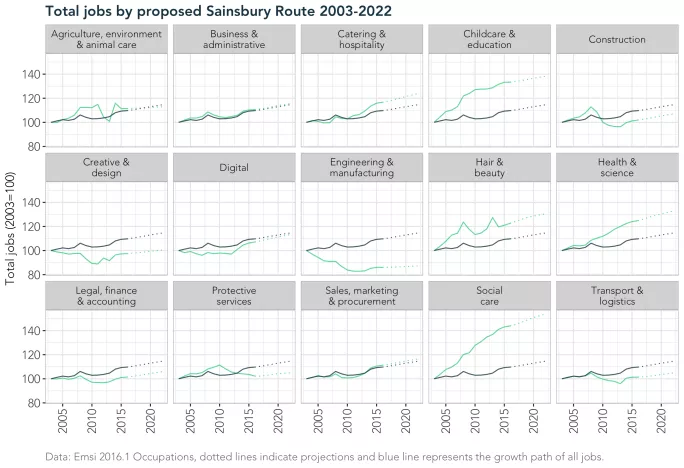- Home
- Sainsbury review: ‘Why mapping technical routes with labour market demand will be crucial’
Sainsbury review: ‘Why mapping technical routes with labour market demand will be crucial’

If all goes according to plan, the recommendations presented in the government’s post-16 skills plan will come into effect in 2019. Drawing on the recommendations of the report of the independent panel on technical education, better known as the Sainsbury review, the proposals are designed, in the words of the then minister of state for skills, Nick Boles, to enhance technical education and build “a dynamic, high-quality technical option, which is grounded in engagement with employers, fits soundly with the rest of the system and is responsive to the changing needs of the economy.”
To achieve this, the Sainsbury review recommended a much simplified system, where instead of the current system of over 13,000 qualifications available for 16-18 year-olds, there would be two basic options - academic and technical - and within the technical option “a common framework of 15 routes is established which encompasses all employment-based and college-based technical education at levels 2 to 5.”
According to the post-16 skills plan, the new system is designed to ”prepare individuals for skilled employment which requires technical knowledge and practical skills valued by industry. It will cover college-based and employment-based (apprenticeship) education, building on our apprenticeship reforms…employers will sit at the heart of the system and take the lead in setting the standards. Crucially, standards will be designed by considering what is needed to move to skilled employment and then working backwards.”
The idea of working backwards is basically a call to replace a supply-led system with a demand-led one, but if this is to be achieved and technical routes are to be established as being more in line with the real needs of employers, it begs the question: “How do we know what those needs actually are?”
Future job prospects
The answer to this question is to map the occupations within the 15 routes to labour market demand, enabling us to identify trends, current jobs and forecast data for each route (we should say that although the routes have been proposed by Lord Sainsbury, the final routes may differ a little when they are implemented by the government). The graphs below show this exercise at the national level, with the first of the three showing the demand for each of the routes (green line), in comparison with the demand for all jobs throughout the country (blue line):

Job growth projections are not, however, an especially good indicator of job demand. The reason for this is that in addition to actual job growth, there is a constant churn within occupations. For instance, if someone retires and the organisation replaces them, the total number of jobs does not increase, but the number of openings goes up by one. The graph below shows this dynamic, not only showing the total number of openings in each of the Sainsbury routes, but also a breakdown between job churn (replacement) and new jobs (expansion):

Another useful exercise is to compare the number of openings with the current number of jobs in each route. What this does is tell us where some of the biggest needs are, relative to the current size of the workforce. So whereas the previous graph told us that the biggest number of openings is in the business and administrative route, the graph below shows us that relative to current workforce, the recruitment needs in hair and beauty and social care are larger:

However, it is when we get down to the county or unitary authority and even local authority level that all of this moves out of the realm of being an interesting academic exercise to one which can really be of practical use. For instance, just to pick one route - business and administrative - and one region - Hampshire (including Southampton and Portsmouth) - we can do the same exercise as we have done above to tell us that:
- The number of occupations in the business and administrative route in Hampshire is currently 65,946 and set to grow by 2,614 jobs from 2016-2022
- Total business and administrative openings in Hampshire between 2016 and 2022 will be around 19,561, of which 16,947 will be replacement jobs and 2,614 new jobs
- Openings in business and administrative occupations in Hampshire from 2016-2022, as a percentage of 2016 jobs, will be 29.66 per cent, of which 25.70 per cent are replacement jobs and 3.96 per cent new jobs
One further exercise we can do is instead of just looking at the broad technical routes, as we have done in the figures and graphs above, we can delve into the individual occupations within the routes to pick out trends. For instance, looking once more at the business and administrative route in Hampshire, we can pick one of the occupations - management consultants and business analysts - and do the same exercise as we did above for the broader technical route:
- The number of management consultants and business analyst occupations in Hampshire is currently 4,939 and set to grow by 245 from 2016-2022
- Total management consultants and business analyst openings in Hampshire between 2016 and 2022 will be around 1,594, of which 1,349 will be replacement jobs and 245 new jobs
- Openings among management consultants and business analysts in Hampshire from 2016-2022, as percentage of 2016 jobs, will be 32.27 per cent, of which 27.31 per cent are replacement jobs and 4.96 per cent new jobs
‘This can be done’
The hope for the new, simplified system of technical routes, according to Mr Boles in his foreword to the post-16 skills plan, is that it will “bring training for young people and adults in line with the needs of business and industry” and that this will “drive up productivity, which has lagged behind in this country even as economic growth and employment have improved”.
However, if the new system is really to have the intended effect, understanding the actual demand for the jobs to which the new technical routes lead will be vital. What we have demonstrated above, firstly looking at the national level, and then with a brief snapshot of a more local and regional level, is that this can indeed be done.
Want to keep up with the latest education news and opinion? Follow TES FE News on Twitter, like us on Facebook and follow us on LinkedIn
Keep reading for just £1 per month
You've reached your limit of free articles this month. Subscribe for £1 per month for three months and get:
- Unlimited access to all Tes magazine content
- Exclusive subscriber-only stories
- Award-winning email newsletters
